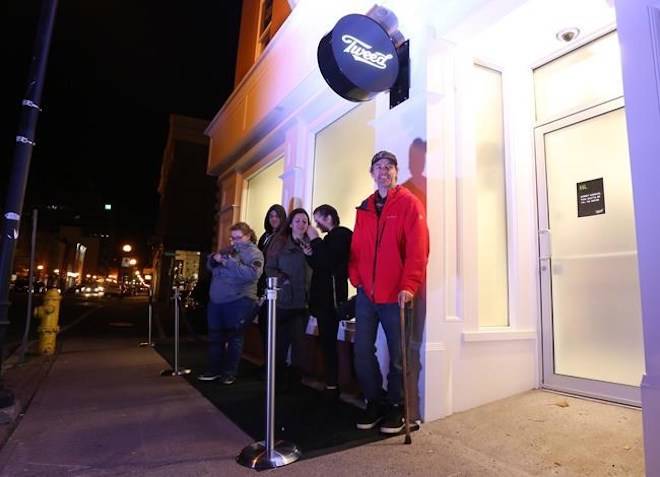High demand for recreational cannabis across Canada drew lineups at brick-and-mortar stores and technical glitches on some online websites in the first hours of legalization.
Government-run and privately operated sales portals went live at 12:01 a.m. local time across Canada, eliciting a wave of demand that resulted in a virtual lineup at Alberta’s e-commerce portal.
At 12:07 a.m. local time, the Alberta Liquor and Gaming Commission tweeted: “You like us! Our website is experiencing some heavy traffic. We are working hard to get it up and running.”
The surge of users “quite simply exceeded our expectations” and in order to avoid an outage customers were put into a queue, said a spokeswoman for the ALGC.
At its peak, albertacannabis.org saw more than 11,000 people waiting to make online purchases but by 12:50 a.m. there was no longer anyone in the queue, she added.
Meanwhile, the Ontario government’s website OCS.ca — the only way to buy cannabis legally in Ontario until physical stores open in April next year — was running smoothly, but the number of dried cannabis products listed online had shrunk by Wednesday morning.
Related: First legal cannabis purchases as midnight strikes in eastern Canada
Related: Puff, puff, pass: Cannabis is officially legal across Canada
Some hardy Newfoundlanders stayed up late Tuesday to witness a moment in national history.
“I’m having a plaque made with the date and time and everything,” Ian Power, who was first in line outside a St. John’s cannabis shop that opened at 12 a.m. local time, said after his purchase.
“This is never actually going to be smoked. I’m going to keep it forever.”
There were early lineups outside pot stores in Nova Scotia, next in line after Newfoundland and Labrador as legalization worked its way across the country’s time zones.
Among those waiting outside a Nova Scotia Liquor Corporation outlet selling cannabis in Sydney River, N.S., was fiddler and pop star Ashley MacIsaac.
“I don’t need to be a criminal anymore, and that’s a great feeling,” said MacIsaac, who in 2001 had been arrested for possession in Saskatchewan. “And my new dealer is the prime minister!”
In Montreal, more than 100 people lined up outside a government-run cannabis store on St-Hubert St. in anticipation of the 10 a.m. opening. The man who was first in line said he arrived at 3:30 a.m.
“It’s a historic day,” said the 38-year-old man, who gave his name as Steve. “I am happy that this is happening during my lifetime.”
The first legal sales in the province were already occurring on the website of the Quebec Cannabis Corp., known by its official French name the Societe quebecoise du cannabis, or SQDC.
Adult Canadians are now able to buy and use recreational cannabis legally, but how and where depends where they live.
The patchwork of regulations governing marijuana varies between provinces and territories, and some municipalities also have the option of adding their own rules or opting out of retail sales altogether.
Smoking or vaping of cannabis is allowed in public places where tobacco is permitted in many provinces or territories, but others such as Manitoba have a ban on public consumption.
Canadians of legal age are also able to grow their own cannabis plants at home — no more than four in most places — but some provinces such as Quebec have chosen to ban personal cultivation.
Cannabis legalization has implications for many other facets of Canadian society, ranging from law enforcement and testing for cannabis-impaired drivers to corporate policies governing consumption restrictions for certain industries such as air travel.
Prime Minister Justin Trudeau has said Canada is ready to give up an old system that did not protect young people or communities from organized criminal involvement in the marijuana trade.
There is expected to be a massive market for legal sales in Canada — as much as $4 billion in the first year, according to a report from consultancy Deloitte.
The number of stores that will open Wednesday remains unclear, but there could be as many as 100 physical locations across the country, depending on whether they pass final inspections or get product shipments in time.
Cannabis products such as dried flower, pre-rolled joints and accessories are available for purchase online and in-store, but edibles won’t be legal until sometime in 2019.
Whether the selection of cannabis products, and pricing, will be enough to entice existing cannabis users away from the illicit market remains to be seen.
Meanwhile, industry players and watchers have said to expect product shortages at the outset.
Licensed producers have been ramping up cannabis production and retailers have been gearing up for months, but both say it has been a compressed timeline for such a complicated endeavour.
Think-tank C.D. Howe warned in a report last week that current supplies of cannabis in the fourth quarter would only meet between 30 and 60 per cent of total demand, but said this would be “short-lived” as more producers are licensed and production capacities expand over time.
Canada needs to “take a deep breath” as U.S. states such as Colorado and California did not have a seamless system at the outset either, said Cam Battley, chief corporate officer for licensed producer Aurora Cannabis.
“We need to remember that this is the start of something, not the end of something…. It’s going to take awhile to iron out all the wrinkles.”
— with files from Holly McKenzie-Sutter in St. John’s, Stephanie Marin in Montreal and Michael Tutton in Halifax
Armina Ligaya, The Canadian Press
Like us on Facebook and follow us on Twitter.

